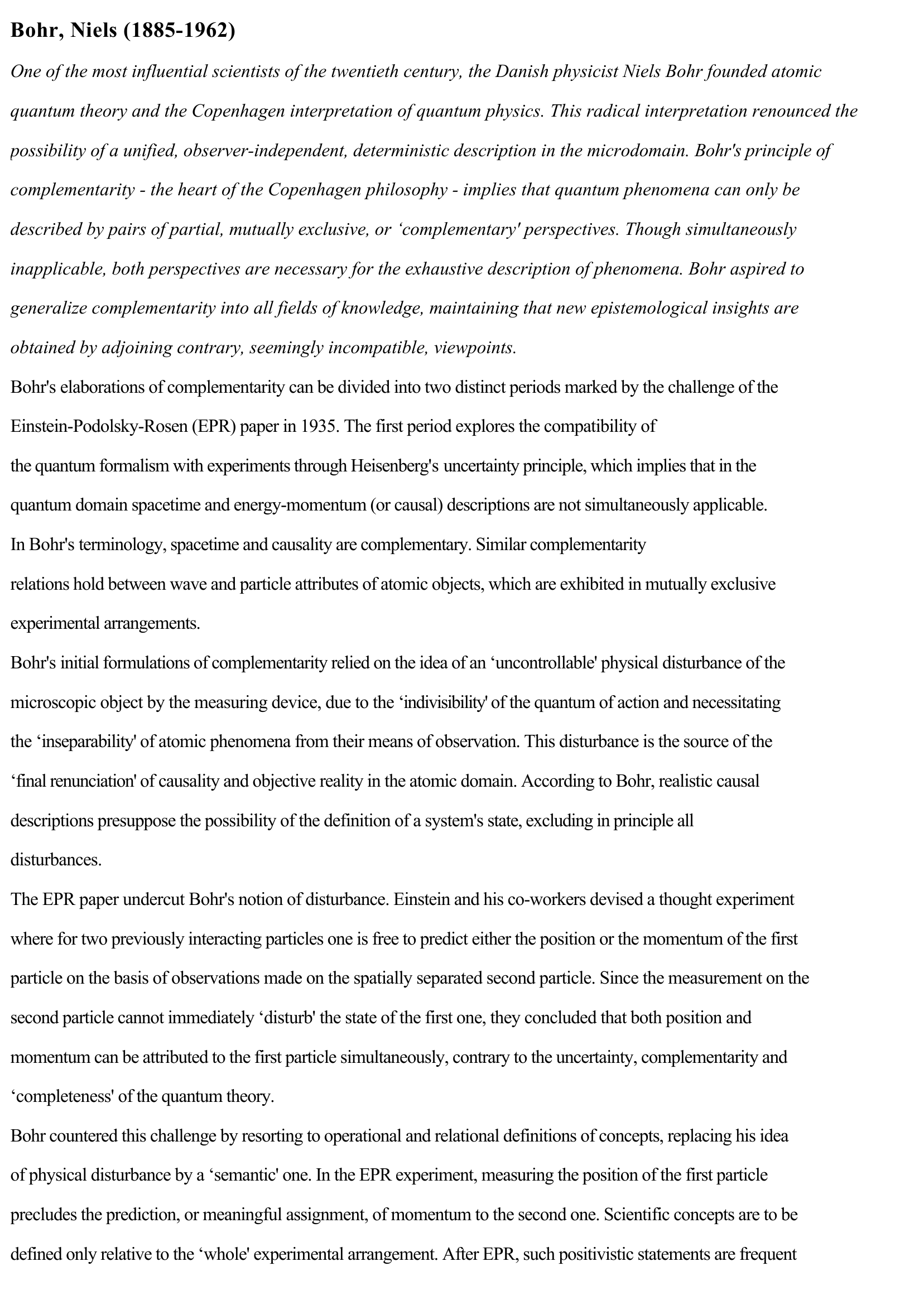Bohr, Niels
Publié le 16/05/2020

Extrait du document
«
Bohr, Niels (1885-1962)
One of the most influential scientists of the twentieth century, the Danish physicist Niels Bohr founded atomic
quantum theory and the Copenhagen interpretation of quantum physics.
This radical interpretation renounced the
possibility of a unified, observer-independent, deterministic description in the microdomain.
Bohr's principle of
complementarity - the heart of the Copenhagen philosophy - implies that quantum phenomena can only be
described by pairs of partial, mutually exclusive, or ‘complementary' perspectives.
Though simultaneously
inapplicable, both perspectives are necessary for the exhaustive description of phenomena.
Bohr aspired to
generalize complementarity into all fields of knowledge, maintaining that new epistemological insights are
obtained by adjoining contrary, seemingly incompatible, viewpoints.
Bohr's elaborations of complementarity can be divided into two distinct periods marked by the challenge of the
Einstein-Podolsky-Rosen (EPR) paper in 1935.
The first period explores the compatibility of
the quantum formalism with experiments through Heisenberg 's uncertainty principle, which implies that in the
quantum domain spacetime and energy-momentum (or causal) descriptions are not simultaneously applicable.
In Bohr's terminology, spacetime and causality are complementary.
Similar complementarity
relations hold between wave and particle attributes of atomic objects, which are exhibited in mutually exclusive
experimental arrangements.
Bohr's initial formulations of complementarity relied on the idea of an ‘uncontrollable' physical disturbance of the
microscopic object by the measuring device, due to the ‘indivisibility' of the quantum of action and necessitating
the ‘inseparability' of atomic phenomena from their means of observation.
This disturbance is the source of the
‘final renunciation' of causality and objective reality in the atomic domain.
According to Bohr, realistic causal
descriptions presuppose the possibility of the definition of a system's state, excluding in principle all
disturbances.
The EPR paper undercut Bohr's notion of disturbance.
Einstein and his co-workers devised a thought experiment
where for two previously interacting particles one is free to predict either the position or the momentum of the first
particle on the basis of observations made on the spatially separated second particle.
Since the measurement on the
second particle cannot immediately ‘disturb' the state of the first one, they concluded that both position and
momentum can be attributed to the first particle simultaneously, contrary to the uncertainty, complementarity and
‘completeness' of the quantum theory.
Bohr countered this challenge by resorting to operational and relational definitions of concepts, replacing his idea
of physical disturbance by a ‘semantic' one.
In the EPR experiment, measuring the position of the first particle
precludes the prediction, or meaningful assignment, of momentum to the second one.
Scientific concepts are to be
defined only relative to the ‘whole' experimental arrangement.
After EPR, such positivistic statements are frequent.
»
↓↓↓ APERÇU DU DOCUMENT ↓↓↓
Liens utiles
- Niels Bohr par J.
- Niels Bohr Fils d'un professeur de physiologie, Bohr obtint son doctorat de physiqueen 1911 à l'université de Copenhague.
- Niels Bohr
- Niels Bohr
- Bohr Niels


